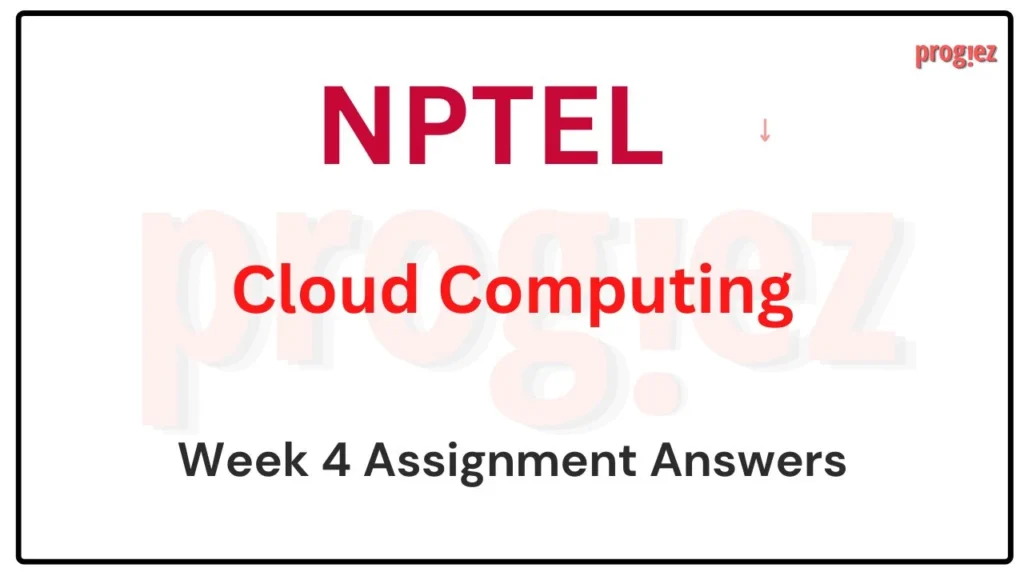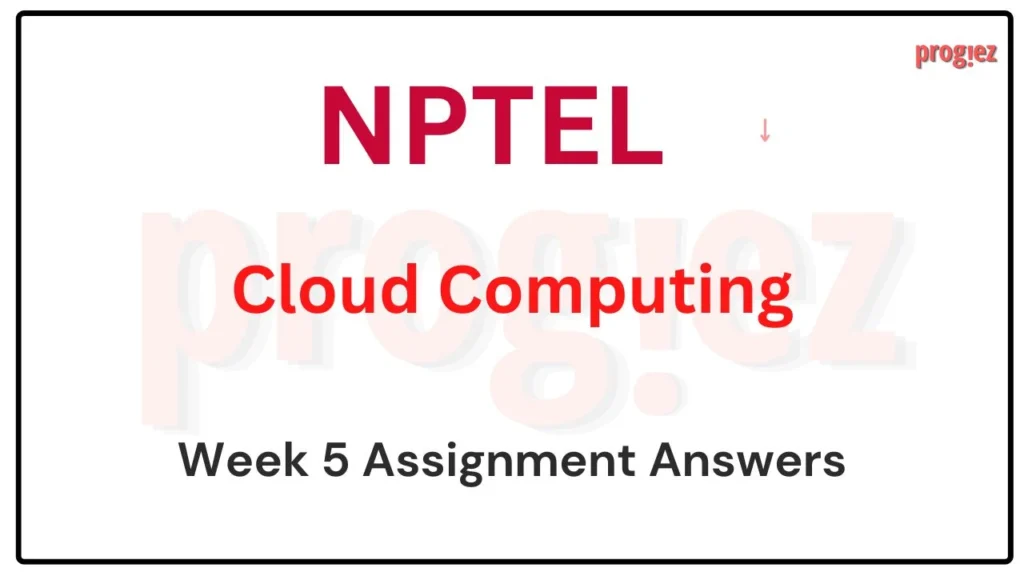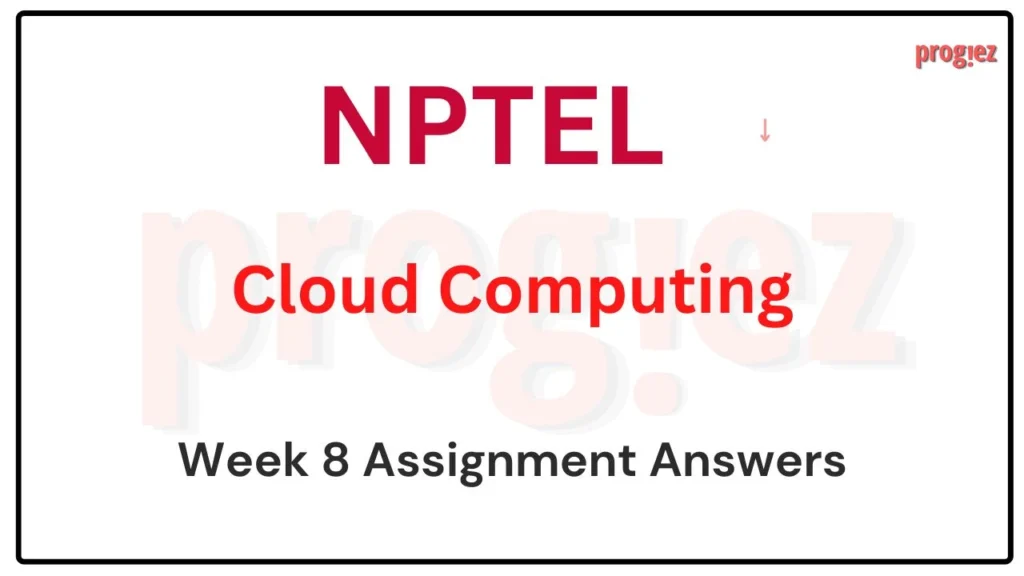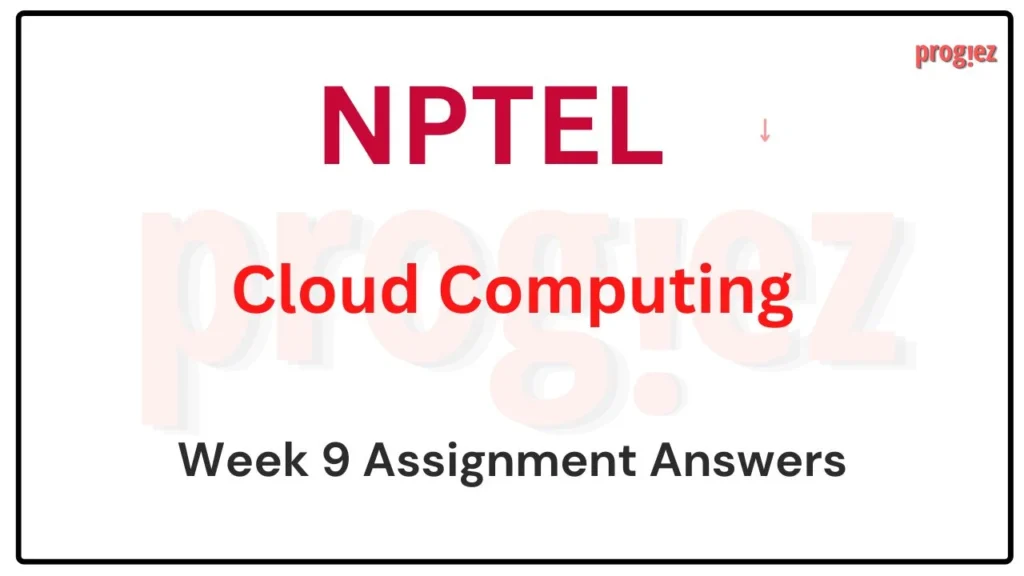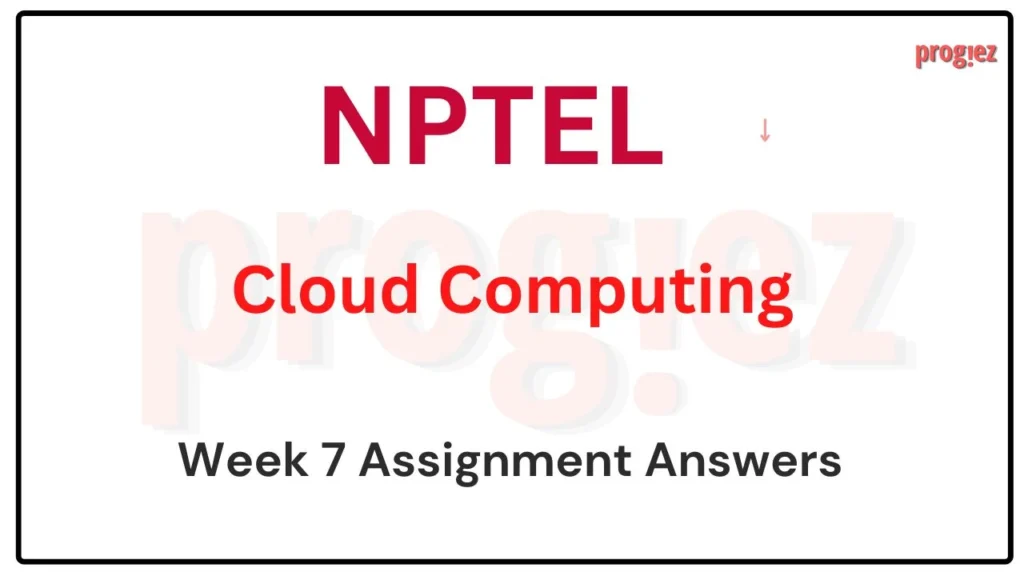Cloud Computing Nptel Week 3 Assignment Answers
Course Link: Click Here
Table of Contents
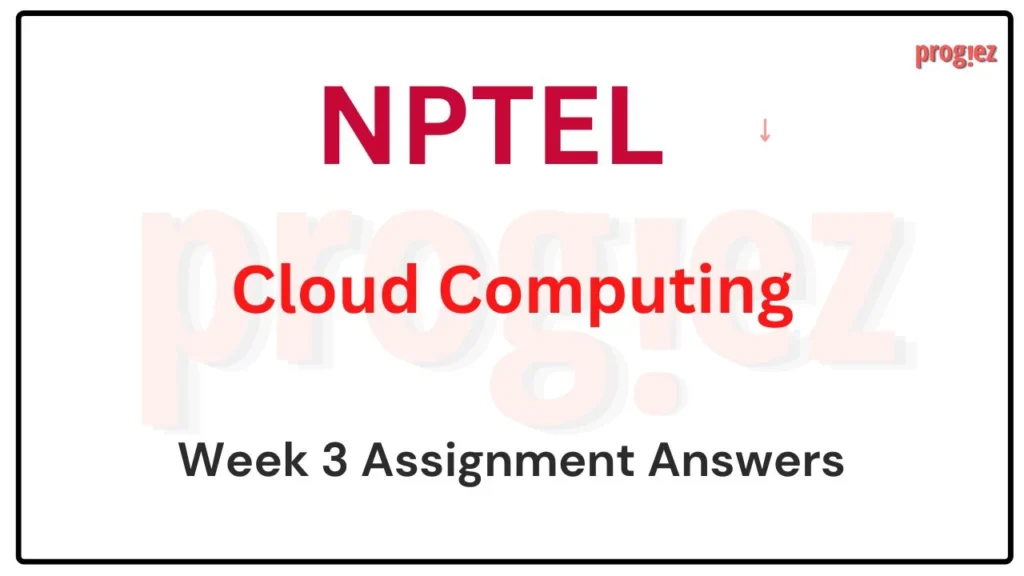
Cloud Computing Nptel Week 3 Assignment Answers (July-Dec 2024)
Q1.Which of the following statement(s) regarding OpenStack storage is/are right?
A. Object storage is managed by Cinder
B. Both ephemeral storage and block storage are accessible from within VM
C. Block storage persists until VM is terminated
D. Ephemeral storage is used to run operating system and/or scratch space
Answer: Updating soon (in progress)
Q2. XML is designed to describe _.
A. M = T
B. M = T/(Eff×P)
C. M = T/P
D. M = (T×Eff)/P
Answer: Updating soon (in progress)
For answers or latest updates join our telegram channel: Click here to join
These are Cloud Computing Nptel Week 3 Assignment Answers
Q3. What does the term “biasness towards vendors” imply in the context of SLA monitoring?
A. Vendor-driven selection of monitoring parameters
B. Customer-driven selection of monitoring parameters
C. Balanced approach in monitoring parameters
D. Lack of active monitoring on the customer’s side
Answer: Updating soon (in progress)
Q4.How does the master node in the Google File System maintain communication with chunk servers?
A. Command messages
B. Update messages
C. Query messages
D. Heartbeat messages
Answer: Updating soon (in progress)
For answers or latest updates join our telegram channel: Click here to join
These are Cloud Computing Nptel Week 3 Assignment Answers
Q5.In a cloud, total service uptime is 175 minutes and availability of the service is 0.85. What is the service downtime?
A. 55 minutes
B. 148.75 minutes
C. 26.25 minutes
D. 45 minutes
Answer: Updating soon (in progress)
Q6.Statement 1: In ephemeral storage, the stored objects persist until the VM is terminated.
Statement 2: The ephemeral storage is managed by Cinder in OpenStack.
A. Statement 1 is TRUE, Statement 2 is FALSE
B. Statement 2 is TRUE, Statement 1 is FALSE
C. Both statements are TRUE
D. Both statements are FALSE
Answer: Updating soon (in progress)
For answers or latest updates join our telegram channel: Click here to join
These are Cloud Computing Nptel Week 3 Assignment Answers
Q7.“Midsize providers can achieve similar statistical economies to an infinitely large provider” Does this fall under?
A. Correlated demand
B. Dependent demand
C. Independent demand
D. Mixed demand
Answer: Updating soon (in progress)
Q8.Let D(t) and R(t) be the instantaneous demand and resources at time t respectively. If demand is exponential (D(t)=et), any fixed provisioning interval (tp) according to the current demands will fall linearly behind.
A. TRUE
B. FALSE
Answer:
For answers or latest updates join our telegram channel: Click here to join
These are Cloud Computing Nptel Week 3 Assignment Answers
Q9.Which of the following is/are expected common SLA parameter(s) for both Software-as-a-Service and Storage-as-a-Service models?also known as
A. usability
B. scalability
C. recovery
D. None of these
Answer:
Q10.Data retention and deletion by cloud providers do not fall under one of the SLA requirements.
A. True
B. False
Answer:
For answers or latest updates join our telegram channel: Click here to join
These are Cloud Computing Week 3 Assignment 3 Nptel Answers
Cloud Computing NPTEL All weeks: Click Here
For answers to additional Nptel courses, please refer to this link: NPTEL Assignment Answers
Cloud Computing Nptel Week 3 Assignment Answers (Jan-Apr 2024)
Course Name: Cloud Computing
Course Link: Click Here
For answers or latest updates join our telegram channel: Click here to join
These are Nptel Cloud Computing Week 3 Assignment 3 Answers
Q1. Which of the following system/architecture follow(s) Quorum protocol for a large number of concurrent reads & writes?
(a) Google File System (GFS)
(b) BigTable
(c) Dynamo
(d) None of the above
Answer: (c) Dynamo
Q2. Statement 1: In ephemeral storage, the stored objects persist until the VM is terminated.
Statement 2: The ephemeral storage is managed by Cinder in OpenStack.
(a) Statement 1 is TRUE, Statement 2 is FALSE
(b) Statement 2 is TRUE, Statement 1 is FALSE
(c) Both statements are TRUE
(d) Both statements are FALSE
Answer: (a) Statement 1 is TRUE, Statement 2 is FALSE
For answers or latest updates join our telegram channel: Click here to join
These are Nptel Cloud Computing Week 3 Assignment 3 Answers
Q3. Column-oriented storage is efficient for data-warehouse workloads.
(a) TRUE
(b) FALSE
Answer: (a) TRUE
Q4. Horizon is a self-service portal to interact with underlying OpenStack services
a) mobile based
b) OS based
c) web based
d) None of the above
Answer: c) web based
For answers or latest updates join our telegram channel: Click here to join
These are Nptel Cloud Computing Week 3 Assignment 3 Answers
Q5. What is the parallel efficiency (Eff) of an algorithm, when a task takes time T in uniprocessor system. P is number of processors. M is time taken by each processor?
(a) Eff = (TP)/M
(b) Eff = T (M/P)
(c) Eff = TPM
(d) Eff = T/(P*M)
Answer: (d) Eff = T/(P*M)
Q6. In cloud, service downtime is 30 minutes and availability of the service is 0.80. What is the service uptime?
(a) 120 minutes
(b) 60 minutes
(c) 150 minutes
(d) 135 minutes
Answer: (c) 150 minutes
For answers or latest updates join our telegram channel: Click here to join
These are Nptel Cloud Computing Week 3 Assignment 3 Answers
Q7. Which of the following is/are NOT SLA requirement(s) of PaaS cloud delivery model?
a. Data Retention and Deletion
b. Privacy
c. Machine-Readable SLAS
d. Certification
Answer: a, c
a. Data Retention and Deletion
c. Machine-Readable SLAS
Q8. What does the ‘availability’ metric represent in the monitoring and auditing of SLAs?
a) The speed at which a service responds
b) How often the service is available
c) The ability for a resource to grow infinitely
d) The percentage of uptime for a service
Answer: d) The percentage of uptime for a service
For answers or latest updates join our telegram channel: Click here to join
These are Nptel Cloud Computing Week 3 Assignment 3 Answers
Q9. What architecture is used in a parallel database for the efficient execution of SQL queries?
a) Shared memory architecture
b) Shared disk architecture
c) Shared nothing architecture
d) Shared cache architecture
Answer: c) Shared nothing architecture
Q10. _________ is used for networking services in OpenStack.
a) Keystone
b) Neutron
c) Cinder
d) Swift
Answer: b) Neutron
For answers or latest updates join our telegram channel: Click here to join
These are Nptel Cloud Computing Week 3 Assignment 3 Answers
More Weeks of Cloud Computing: Click here
More Nptel Courses: Click here
Cloud Computing Nptel Week 3 Assignment Answers (July-Dec 2023)
Course Name: Cloud Computing
Course Link: Click Here
These are Nptel Cloud Computing Week 3 Assignment 3 Answers
1) In the context of aggregated demand in resource provisioning in the cloud, how does adding n independent demands affect the coefficient of variation (Cv)?
A) Increases the Cv
B) Decreases the Cv
C) Does not change the Cy
D) Inversely proportional to the mean
Answer: B) Decreases the Cv
2) What does the term “biasness towards vendors” imply in the context of SLA monitoring?
A) Vendor-driven selection of monitoring parameters
B) Customer-driven selection of monitoring parameters
C) Balanced approach in monitoring parameters
D) Lack of active monitoring on the customer’s side
Answer: A) Vendor-driven selection of monitoring parameters
3) In the Openstack storage concept, _______ storage persists until the VM is terminated and is managed by _________.
A) Nova, Cinder
B) Ephemeral, Cinder
C) Cinder, Ephemeral
D) Ephemeral, Nova
Answer: D) Ephemeral, Nova
These are Nptel Cloud Computing Week 3 Assignment Answers
4) What condition makes periodic provisioning acceptable in the presence of linear demand?
A) High resource utilization
B) Non-linear demand
C) Instantaneous demand
D) Flat demand
Answer: D) Flat demand
5) What is (are) the key factor(s) to consider in a hybrid model for utility pricing?
A) Reliability and accessibility
B) Network cost and usage costs
C) Peak to average demand ratio
D) Interoperability overhead
Answer: C) Peak to average demand ratio
6) What architecture is used in a parallel database for the efficient execution of SQL queries?
A) Shared memory architecture
B) Shared disk architecture
C) Shared nothing architecture
D) Shared cache architecture
Answer: C) Shared nothing architecture
These are Nptel Cloud Computing Week 3 Assignment Answers
7) What type of environment benefits from utility pricing?
A) Environments with fixed demand levels
B) Environments with limited resource scalability
C) Environments with variable demand levels
D) Environments with prepaid resource allocation
Answer: C) Environments with variable demand levels
8) What is the role of Neutron in the provisioning flow in OpenStack?
A) Fetches information about the whole cluster from the database
B) Publishes a message to the compute queue to trigger VM provisioning
C) Configures IP, gateway, DNS name, and L2 connectivity.
D) Contacts Cinder to get volume data
Answer: C) Configures IP, gateway, DNS name, and L2 connectivity.
9) How does the master node in the Google File System maintain communication with chunk servers?
A) Command messages
B) Update messages
C) Query messages
D) Heartbeat messages
Answer: D) Heartbeat messages
These are Nptel Cloud Computing Week 3 Assignment Answers
10) What does the ‘availability’ metric represent in the monitoring and auditing of SLAs?
A) The speed at which a service responds
B) The percentage of uptime for a service
C) How often the service is available
D) The ability for a resource to grow infinitely
Answer: B) The percentage of uptime for a service
These are Nptel Cloud Computing Week 3 Assignment Answers
More Weeks: Click here
More Nptel Courses: Click here
Cloud Computing Nptel Week 3 Assignment Answers (Jan-Apr 2023)
Course Name: Cloud Computing
Course Link: Click Here
These are Nptel Cloud Computing Week 3 Assignment Answers
Q1. Which of the following is/are properties of Web Service SLAs?
A. SLA automation is required for negotiation, provisioning, service delivery and monitoring.
B. The QoS parameters are response time, SLA violation rate for reliability, availability and cost of service.
C. UDDI (Universal Description Discovery and Integration) is used for resource allocation.
D. The QoS parameters are related to security, privacy, trust, management, etc.
Answer: B, C
Q2. A task takes time T in a uniprocessor system. In a parallel implementation, the task runs on P processors parallelly. The parallel efficiency is Eff, where 0<Eff<1. What is the time taken by each processor (M) in this implementation?
A. M=T
B. M = T/(EffxP)
C. M=T/P
D. M=(TxEff)/P
Answer: B. M = T/(EffxP)
These are Nptel Cloud Computing Week 3 Assignment Answers
Q3. Row-oriented storage is optimal for transaction processing applications.
A. True
B. False
Answer: A. True
Q4. Which of the following is/are the SLA requirement(s) for PaaS cloud delivery model?
A. Transparency
B. Data Retention and Deletion
C. Privacy
D. Regulatory compliance
Answer: A, C, D
These are Nptel Cloud Computing Week 3 Assignment Answers
Q5. In a cloud, total service uptime is 175 minutes and availability of the service is 0.85. What is the service downtime?
A. 55 minutes
B. 148.75 minutes
C. 26.25 minutes
D. 45 minutes
Answer: C. 26.25 minutes
Q6. Which of the following database system/architecture follow(s) Quorum protocol for a large number of concurrent reads & writes?
A. BigTable
B. Dynamo
C. Datastore
D. Google File System (GFS)
Answer: B. Dynamo
These are Nptel Cloud Computing Week 3 Assignment Answers
Q7. Match the components of OpenStack with their functions.
A. 1->B, 2->D, 3->A, 4->C
B. 1->B, 2->A, 3->D, 4->C
C. 1->C, 2->B, 3->D, 4->A
D. 1->D, 2->A, 3->B, 4->C
Answer: D. 1->D, 2->A, 3->B, 4->C
Q8. Let D(t) and R(t) be the instantaneous demand and resources at time t respectively. If demand is exponential (D(t)=e’), any fixed provisioning interval (tp) according to the current demands will fall linearly behind.
A. TRUE
B. FALSE
Answer: B. FALSE
These are Nptel Cloud Computing Week 3 Assignment Answers
Q9. Which of the following statement(s) regarding OpenStack storage is/are wrong?
A. Object storage is managed by Cinder
B. Both ephemeral storage and block storage are accessible from within VM
C. Block storage persists until VM is terminated
D. Ephemeral storage is used to run operating system and/or scratch space
Answer: A, C
Q10. Statement 1: Multiple KPIs are aggregated to SLA.
Statement 2: SLA contains SLO.
A. Both statement 1 and 2 are correct
B. Statement 1 is correct and statement 2 is incorrect
C. Statement 2 is correct and statement 1 is incorrect
D. Both statement 1 and 2 are incorrect
Answer: C. Statement 2 is correct and statement 1 is incorrect
Nptel Cloud Computing Week 3 Assignment Answers
All weeks of Cloud Computing: Click here
More NPTEL course: Click Here
Cloud Computing Nptel Week 3 Assignment Answers (July-Dec 2022)
Course name: Cloud Computing NPTEL
Link to Enroll: Click Here
These are Nptel Cloud Computing Week 3 Assignment Answers
Q1. Which of the following is/are NOT SLA requirement(s) of PaaS cloud delivery model?
a. Privacy
b. Data Retention and Deletion
c. Machine-Readable SLAs
d. Certification
Answer: c. Machine-Readable SLAs
Q2. Which of the following is/are true regarding penalty cost? (Here D(t) and R(t) are instantaneous demand and resources at time t.)
a. Penalty cost ox ID()/R()|dt
b. If demand is flat, penalty is equal to 0.
c. If demand is exponential (D(t)=e’), any fixed provisioning interval (tp) according to the current demands will fall linearly behind.
d. The penalty cost for exponential demand is exponential.
Answer: b, d
Q3. Row-oriented storage is efficient for data-warehouse workloads.
a. TRUE
b. FALSE
Answer: b. FALSE
These are Nptel Cloud Computing Week 3 Assignment Answers
Q4. Which of the following is/are example(s) of cloud SLA(s) with IlaaS delivery model?
a. Amazon EC2
b. Google App Engine
c. Salesforce CRM
d. Zoho mail
Answer: a. Amazon EC2
Q5. Which of the following OpenStack components is used for block storage services?
a. Keystone
b. Cinder
c. Swift
d. Neutron
Answer: b. Cinder
Q6. In cloud, service downtime is 30 minutes and availability of the service is 0.80. What is the service uptime?
(a) 120 minutes
(b) 60 minutes
(c) 150 minutes
(d) 135 minutes
Answer: (c) 150 minutes
These are Cloud Computing Nptel Week 3 Assignment Answers
Q7. In Google File System (GFS), the master maintains regular communication with the chunk servers.
a. TRUE
b. FALSE
Answer: a. TRUE
Q8. In a system, 400 unit workloads have been added. What will be the penalty?
a. 40%
b. 100 %
c. 20%
d. 8000%
Answer: c. 20%
Q9. Which of the following option(s) is/are correct?
a. Service Level Agreement(SLA) contains Service Level Objectives(SLO)
b. Service Level Objectives(SLO) contains Service Level Agreement(SLA)
c. Multiple Service Level Agreements (SLAs) are aggregated to Key Performance Indiocator (KPI)
d. Key Performance Indiocators (KPIs) are aggregated to Service Level Objectives(SLO)
Answer: a, d
These are Cloud Computing Nptel Week 3 Assignment Answers
Q10. Statement 1: In OpenStack block storage, the stored objects persist until the VM is terminated.Statement 2: In OpenStack ephemeral storage, the stored objects are accessible from within VM as local file system.
a. Both statement 1 and 2 are correct
b. Statement 1 is correct and statement 2 is incorrect
c. Statement 2 is correct and statement 1 is incorrect
d. Both statement 1 and 2 are incorrect
Answer: c


